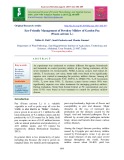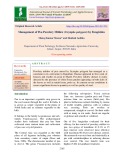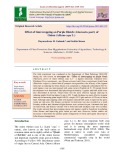
Management of pea powdery mildew
-
An experiment was conducted to evaluate different bio-agents, biorationals and botanicals to control powdery mildew of pea. During evaluation, all the seven treatments viz. hexaconazole, NSKE, Lantana camara leaf extract, B. subtilis, T. harzianum, cow urine, butter milk were found to be significantly superior over control in managing the powdery mildew disease. Among all treatments, T1 (Hexaconazole 5 EC- 0.05%), T2 (NSKE 5%), T5 (T. harzianum 0.4%), T6 (cow urine 10%), T3 (Lantana camara leaves extract 10%) were significantly superior over other treatments for managing powdery mildew.
 6p
6p  nguaconbaynhay6
nguaconbaynhay6
 24-06-2020
24-06-2020
 12
12
 0
0
 Download
Download
-
Pea powdery mildew is an air-borne disease of worldwide distribution. It is particularly damaging in late sowings or in late maturing varieties. It is caused by Erysiphe pisi. In order to bring residue free peas, there is need to manage these diseases through ecofriendly measures such as by using the chitosan which is antifungal as well as induces resistance in plants. GI chitosan is a deacetylated derivative of chitin obtained by gamma irradiation of chitosan.
 7p
7p  nguaconbaynhay4
nguaconbaynhay4
 22-03-2020
22-03-2020
 14
14
 2
2
 Download
Download
-
Powdery mildew of pea caused by Erysiphe polygoni has emerged as a constraint in its cultivation in Rajasthan. Disease appeared in first week of January and reaches its peak in March. Powdery mildew disease is easily detected by the presence of white floury patches appearing on both sides of the leaves as well as tendril stem, pods etc. In extreme severe conditions it causes significant losses in quantity as well as quality of seed.
 4p
4p  nguaconbaynhay4
nguaconbaynhay4
 22-03-2020
22-03-2020
 13
13
 2
2
 Download
Download
-
Experiments were conducted at Sartingal farm of Regional Horticulture Research Substation (RHRSS) Bhaderwah, Doda, SKUAST-Jammu in randomized block design with eight treatments replicated thrice to assess the losses caused by economically important diseases of pea viz., Ascochyta blight and powdery mildew of pea (Pisum sativum L.). Eight different fungicides and bioagents evaluated as foliar spray, recorded significant reduction against ascochyta blight and powdery mildew disease incidence with a concomitant significant increase in yield over control.
 7p
7p  quenchua2
quenchua2
 16-12-2019
16-12-2019
 8
8
 0
0
 Download
Download
-
The field experiment was conducted at the Department of Plant Pathology SHUATS during the rabi season, to investigate the “Effect of intercropping on purple blotch (Alternaria porri) of onion (Allium cepa L.)” a legume intercrops evaluated were. Chickpea (Cicer arientinum), pea (Pisum sativum), lentil (Lens esculantum), french bean (Phaseolus vulgaris), cluster bean (Cyamopsis tetragonoloba), the efficacy of the legume intercrops in reducing the foliar disease was compared to a fungicide carbendazim (0.1%).
 7p
7p  cothumenhmong1
cothumenhmong1
 08-12-2019
08-12-2019
 17
17
 0
0
 Download
Download
CHỦ ĐỀ BẠN MUỐN TÌM


















